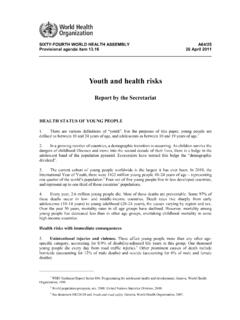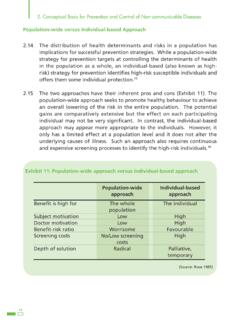Transcription of Gender - World Health Organization
1 mental Health problems are among the most important contributors to the global burden of disease and disability. mental and neurological conditions account for of disability adjusted life years (DALYs) lost globally and 31% of all years lived with disability at all ages and in both sexes, according to 2000 estimates. These conditions are a concern in industrialised as well as in developing countries, where the mental Health situation has shown limited improvement, and may have deteriorated signifi cantly in many communities.)June 2002In addition to the millions suff er ing from defi ned men tal disorders, there are millions of others who, be cause of ex- treme ly diffi cult conditions or cir cum stanc es of life, are at special risk of being aff ect ed by mental Health prob lems.
2 These include per sons living in ex treme pov er ty, children and ad o les cents ex pe ri enc ing disrupted nur tur ing, aban- doned eld er ly, wom en and children ex pe ri enc ing violence, those traumatized by war and vi o lence, refugees and dis- placed per sons, and many in dig e nous people. Research shows that socially constructed diff er enc es between women and men in roles and re spon si bil i ties, sta tus and power, interact with bi o log i cal diff er enc es be tween the sexes to con trib ute to diff er enc es in the nature of men tal Health problems suff ered, Health seek ing be hav iour of those aff ected and re spons es of the Health sec tor and so ci e ty as a whole. How ev er, it is im por tant to remember, when re view ing avail a ble evidence in this re gard, that there are major gaps.
3 More is known about diff erences be tween males and fe males in some mental Health prob lems such as depression and schizophrenia than others; about adult men and wom en than about ad o les cents and children; and about the sit u a tion in in- dus tr ial ised coun tries than in the de vel op ing World . What do we know?Sex diff erences in prevalence, onset and course of disorders Although there do not appear to be sex diff erences in the overall prev a lence of mental and behavioural dis or ders, there are signifi cant diff erences in the patterns and symp-toms of the disorders. These diff erences vary across age groups. In childhood, most studies report a higher prev- a lence of conduct disorders, for example with ag gres sive and antisocial behaviours, among boys than in girls.
4 During adolescence, girls have a much higher preva-lence of depression and eating disorders, and engage more in suicidal ideation and suicide attempts than boys. Boys experience more problems with anger, engage in high-risk behaviours and commit suicide more frequently than girls. In gen er al, adolescent girls are more prone to symptoms that are directed inwardly, while adolescent boys are more prone to act adulthood, the prevalence of depression and anx i e ty is much higher in women, while substance use dis or ders and antisocial behaviours are higher in men. In the case of severe mental disorders such as schiz o phre nia and bi-polar depression, there are no con sist ent sex diff erences in prevalence, but men typically have an earlier onset of schizophrenia, while women are more likely to exhibit serious forms of bipolar depression.
5 In older age groups, although the incidence rates for Alzheimer s disease a degenerative disease of the brain which usually occurs after 65 years of age is re port ed to be the same for women and men, women s longer life expectancy means that there are more women than men living with the condition. With the exception of China and parts of India, the rate of death by suicide is higher for men than wom en in almost all parts of the World by an aggregate ratio of :1. Again, although men die by suicide more fre quent ly than women do, suicide attempts are re port ed to be con sis- Gender and mental Healtht ent ly more common among wom en than men, ac cord ing to a 1999 study covering sites in nine the occurrence of more than one dis- or der concurrently is associated with increased se ver i ty of mental illness and higher levels of disability.
6 Recent studies have found that women had sig nifi cant ly high er lifetime and 12 month comorbidity than factorsThe interaction between biological and social vulnerabilityGenetic and biological factors play some role in the high- er prevalence of depressive and anxiety disorders among women. Mood swings related to hormonal chang es as a part of the menstrual cycle are doc u ment ed by some the case of antenatal and postnatal depression, the interaction of psychosocial factors with hormonal fac- tors appears to result in an elevated risk. For ex am ple, marital disharmony, inadequate social sup port and poor fi nancial situation are associated with an in creased risk of postnatal depression. Women may also experience considerable psycholo-gical distress and disorders associated with re pro duc tive Health conditions and problems.
7 Infertility and hysterectomy have been found by some studies to increase women s risk of aff ective/neurotic syndromes. A re cent study from the United States fi nds that adults with bladder control problems, a condition more com- mon in older women than in older men, in di cat ed more emotional distress and symptoms of de pres sion when compared to continent adults. The mental Health con- se quenc es of other common gy nae co log i cal con di tions in older women, such as ute ro-vaginal prolapse, need to be explored contrast to the vast literature on women s re pro duc tive biology and mental Health , especially from in dus tri al ized countries, there is little research on the contribution of men s reproductive functioning to their mental Health , from either developing or in dus tri al ized rolesA large number of studies provide strong evidence that Gender based diff erences contribute signifi cantly to the higher prevalence of depression and anxiety disorders in girls and women when compared to boys and men.
8 For example, the lower self esteem of adolescent girls when compared to boys in the same age group, and their anx i e ty over their body-image is known to result in a high er prevalence of depression and of eating dis or ders in ad o les cent girls when compared to adolescent feeling of a lack of autonomy and control over one s life is known to be associated with depression. So-cially determined Gender norms, roles and responsibilities place women, far more frequently than men, in situations where they have little control over important decisions concerning their lives. Studies from industrialised countries have reported that the frequent exposure of low-income women to uncontrollable life events such as illness and death of children or of husbands, imprisonment, job in se cu ri ty, dangerous neighbourhoods and haz ard ous workplaces places them at a signifi cantly higher risk of depression than men.
9 The same problems in men may be as so ci at ed with abuse of alcohol or other drugs, and vi o lence. A study from China suggests that the distress caused to women by factors such as arranged marriages, un-wanted abor tions, in-law problems and an enforced nurturing role precipitates psychological the other hand, the socialisation of men to not ex- press their emotions and to be dependent on women for many aspects of domestic life may con trib ute to high levels of distress among them when faced with situations such as bereavement. Many studies from the US and UK report that a greater proportion of widowers experienced mental and physical Health problems than did widows, although both women and men were vulnerable to ill-nesses and ailments on losing a based violenceData, although fragmentary, indicate strong as so ci a tions between Gender based violence and mental Health .
10 De pres sion, anxiety and stress-related syndromes, de- pend ence on psychotropic medications and substance use and su i cide are mental Health problems associated with violence in women s lives. A population-based study from Nicaragua has found that women who had experienced severe abuse during the last year were ten times more likely to experience emo-tional distress than women who had never ex pe ri enced abuse. Severity of the abuse appeared to be the major predictor, independently of the time period in which the abuse had taken place. Data from eight countries around the World reveal a highly signifi cant re la tion ship be tween lifetime experience of physical violence by an intimate partner and suicide ideation (Table 1).















